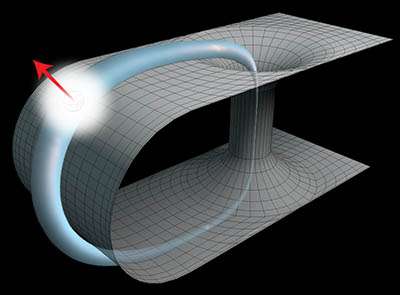Simulating time travel: Doctor Who meets Professor Heisenberg

(Phys.org)—University of Queensland researchers have simulated time travel using light particles. Lead author and PhD student Martin Ringbauer, from UQ's School of Mathematics and Physics, said the study used photons – single particles of light – to simulate quantum particles traveling through time and study their behavior, possibly revealing bizarre aspects of modern physics.
"The question of time travel features at the interface between two of our most successful yet incompatible physical theories – Einstein's general relativity and quantum mechanics," Mr Ringbauer said.
"Einstein's theory describes the world at the very large scale of stars and galaxies, while quantum mechanics is an excellent description of the world at the very small scale of atoms and molecules."
Einstein's theory suggests the possibility of travelling backwards in time by following a space-time path that returns to the starting point in space, but at an earlier time-a closed timelike curve.
This possibility has puzzled physicists and philosophers alike since it was discovered by Kurt Gödel in 1949, as it seems to cause paradoxes in the classical world, such as the grandparents paradox, where a time traveller could prevent their grandparents from meeting, thus preventing the time traveller's birth.
This would make it impossible for the time traveller to have set out in the first place.
UQ Physics Professor Tim Ralph said it was predicted in 1991 that time travel in the quantum world could avoid such paradoxes.
"The properties of quantum particles are 'fuzzy' or uncertain to start with, so this gives them enough wiggle room to avoid inconsistent time travel situations," he said.
Professor Ralph said there was no evidence that nature behaved in ways other than standard quantum mechanics predicted,but this had not been tested in regimes where extreme effects of general relativity played a role, such as near a black hole.
"Our study provides insights into where and how nature might behave differently from what our theories predict."
Examples of the intriguing possibilities in the presence of closed timelike curves include the violation of Heisenberg's uncertainty principle, cracking of quantum cryptography and perfect cloning of quantum states.
Published in Nature Communications, the paper "Experimental Simulation of Closed Timelike Curves" includes Dr Matthew Broome, Dr Casey Myers, Professor Andrew White and Professor Timothy Ralph, all from The University of Queensland.
More information: Paper: www.nature.com/ncomms/2014/140 … full/ncomms5145.html
Journal information: Nature Communications
Provided by University of Queensland




















